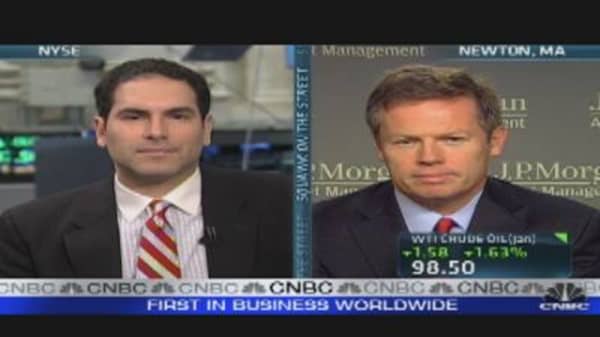Though the stock market has been unable to make a clean break into positive territory this year, there still is hope that 2011 can end on a positive note. Just don't count on mom-and-pop investors to make it happen.
Retail money has been out of the market for most of the year — even during some of Wall Street's most violent rallies — and is largely expected to stay there until the debt and deficit problems in the U.S. and throughout Europeget resolved.
"The retail investor is just fed up," says Brian Gendreau, market strategist with the Financial Network, an El Segundo, Calif.-based independent broker-dealer. "They don't know how they can plan for anything like retirement or buying a home. They're really put off by the volatility."
Indeed, individual investors have been pulling money out of stock-based mutual funds for seven months running, including during the big 10 percent October rally. Bond funds, meanwhile, continue to shine, pulling in $6.8 billion in the week ended Nov. 16 alone, marking the sixth consecutive inflow week that dates, ironically, to the beginning of the October rally.
So who's buying stocks, then?
The action appears to be coming primarily from companies that are looking at their stock prices and seeing bargains where the individual investors do not.
This year, in fact, is shaping up to be the third-biggest year ever for share buybacks, which historically are seen as an uncertain indicator regarding market direction but provide an interesting contrast to the extreme stock aversion among retail investors. (The two larger years for buybacks were in 2006 and 2007, which preceded the bear market ushered in by the financial crisis.)
During the recently completed earnings season, buybacks averaged $2.1 billion a day, with $28.5 billion in buybacks for November as of last week. That's been 1.7 times higher than the $16.3 billion in corporate selling, according to TrimTabs.
"Corporate America is the only real source of buying power in this market," Charles Biderman, TrimTabs CEO, wrote in a market analysis.
The moribund market has provided an opportunity for corporations to put to work some of that $2 trillion in cash that nonfinancial corporations have been sitting on.
Retail investors aren't biting, though.
"The volatility is going to continue until we get some more progress on the policy issues related to the European debt question. There's no end of that in sight," Gendreau says. "Corporations, meanwhile, are looking at their stock prices — they're beaten down, valuations are lower than normal, and they're saying, 'Why not?'"
For Wall Street, then, the main question is when and whether small investors will be willing to come in off the sideline and put some of the $2.64 trillion sitting in money market funds to work.
There appear to be few signs, though, that the dynamic is changing.
"If you want to be particularly pessimistic, that (trend) might be generational," says Dan Greenhaus, chief global strategist at BTIG in New York. "It's not out of the realm of possibility that for anyone over the age of 50, you're not going near equities in a meaningful way ever again."
The picture doesn't get much brighter for younger investors.
"If you're under 20 or under 35, you've only known a period of equity stagnation," Greenhaus says. "The stocks-for-the-long run argument has meant nothing to you."
Greenhaus says the current 11-year stagnation is much like the nearly 20-year period that preceded the 1980s market boom.
"There was a cult of equities born in the '70s, '80s, ;90s, where people were way more into equities during that 30-year period than during the preceding 30 years," he says. "Since 2000, we've lived through WorldCom, Enron, (Ponzi schemers Bernie) Madoff, (Allen) Stanford, any number of recessions, policy mistakes — the attitude of retail investors with respect to equities has soured."
More recently, investors have been cowed by the vicious triple-digit swings up and downthat have dominated trading this year.
Gauges such as the CBOE Volatility Index reflect how retail investors feel about all of the market undulations.
"When you have the volatility index elevated the way it has been it gives the market an unsafe feeling," says Quincy Krosby, market strategist at Prudential Financial in Newark, N.J. "Retail investors, unless they feel really confident that they can go in the equity market and weather the volatility, tend to wait."
Krosby says many of those reluctant investors are justified in their hesitation and desire to preserve capital, but can use a diversified strategy known as a "barbell" to hedge their risk in such an environment. Barbelling usually entails loading up on traditional safe havens, then using high-reward plays like options to capitalize when the market does rally.
Many investors, though, will remain on the sidelines, hoping that the market will find a bottom sometime soon and provide a buying opportunity.
"Many are waiting for a washout," Krosby says. "They have a sense that the market has not found its bottom and is going to retest its October lows. Then they'll come in and buy."





